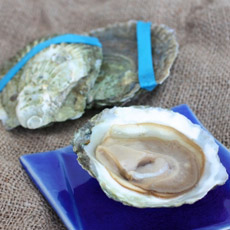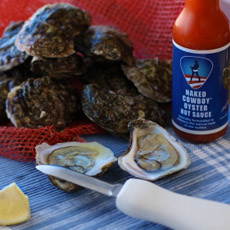

Blue Point oyster. Photo by Glenn Theal | IST.
July 2007
Last Updated April 2013
|
 |
Different Oysters
Oyster Glossary
Part 3: Oyster Types Beginning With A & B
CAPSULE REPORT: This is page three of a nine-page article about different oysters. Here, oyster types beginning with A and B. Click on the black links below to visit other pages. Also visit our many other food glossaries that focus on other favorite foods, including a 13-page Seafood Glossary.
Different Varieties Of Oysters: Overview
While our list of oyster varieties spans five pages and may seem long, there are just five types of oysters available in the U.S. These five are known by multiple names: Flat Oyster (also called Belon and European), Kumamoto, Pacific, Virginica (also called Atlantic or Eastern oyster). Because the terroir significantly impacts the taste and texture of the oyster, Pacifics and Virginicas are named after the area in which they are harvested. Thus, most of the names in this glossary are Pacifics and Virginicas grown in various locales.
Many people enjoy oysters both raw, “on the half shell,” and cooked in a variety of preparations. Those who enjoy them raw appreciate the different flavors of oysters grown in different terroirs, just as wine connoisseurs appreciate the difference a terroir has on a grape varietal. Oysters can be wild or farmed (cultivated or cultured). Cultivation ensures a steady, year-round supply to people who have chosen to pursue the business full-time.
In the U.S., the five oysters consumed are the Atlantic (Virginica) oyster, Flat (Belon or European Flat) oyster, Kumamoto oyster, Olympia oyster and Pacific oyster. Here’s how they differ:

Chart courtesy Greg Babinecz, Raw Bar Manager at Waterbar | San Francisco.
Different Oysters Beginning With A & B
AMERICAN or ATLANTIC OYSTER
See Virginica oyster.
APALACHIOLA OYSTER
A variety of Virginica oyster from Florida, the Apalachiola is believed to be the variety used in the original Oysters Rockefeller, created at Antoine’s restaurant in New Orleans during the Gilded Age. The dish, made with spinach and cream, was named after tycoon John D. Rockefeller, Sr., because they were both so “rich.” The oyster itself has a deep, greenish shell and is plump and sweet, with a hint of copper flavor.
BARRON POINT OYSTER
From Skookum Inlet, Washington with typical Pacific oyster flavors—plump, sweet and fruity.
BÉLON OYSTER
The Bélon (Ostrea angasi) is also called the angasi oyster, European flat oyster and mud oyster. This species, from the estuary of the Bélon River in southern Brittany, France, once dominated European oyster production. Unfortunately disease has sharply reduced the harvests. Today, the hardier Pacific oyster accounts for more than 75% of Europe’s oyster production. U.S. oyster growers farm Bélons in small quantities on both coasts. They are prized for their unique tannic seawater flavor (some say they are dry and metallic), and sell for a substantial premium—two or three times the price of the far more plentiful Pacific oysters. The Bélon has an AOC classification.
“BÉLON” OYSTERS FROM MAINE
Some oyster farmers in Maine are cultivating what are sold as “Bélon” oysters. This is incorrect and illegal: Only oysters harvested from the Bélon River in Brittany, France can be called Bélon oysters. You can’t call a Bordeaux blend wine made in America “Bordeaux.” These oysters can properly be called European oysters or flat oysters, but “Bélon” has the world-famous name and the AOC-protected classification. Even flat oysters grown elsewhere in France cannot be called “Bélon,” but are called “plate,” the French word for flat. Feel free to correct your purveyor. However incorrectly named, the Maine flat oysters are a perfectly fine product, with a tangy, metallic flavor. |
|

Wild belon oysters. Photo courtesy ILoveBlueSea.com. |
BIVALVE
Bivalvia is a class of marine and freshwater mollusks with laterally compressed bodies enclosed by a shell in two hinged parts. In addition to oysters, bivalves include clams, mussels, scallops and numerous other shelled creatures. The majority are filter feeders and have no head or radula. The gills have evolved into ctenidia, specialised organs for feeding and breathing. Most bivalves bury themselves in sediment on the seabed, where they are safe from predators. Others lie on the sea floor or attach themselves to rocks or other hard surfaces. Some bivalves, such as scallops, can swim. (Definition courtesy Wikipeidia.) |
|

The hinge is cut to separate the two halves of the shell. Shown in photo: two oysters, top shell removed. Photo courtesy ILoveBlueSea.com. |
BLUE POINT OYSTER
A variety of Virginica oyster named after a town on Long Island, New York, the center of the Long Island oyster business for several hundred years.
BOX OYSTER
A larger and meatier Virginia oyster from Long Island.
BRAS D’OR OYSTER
From Cape Breton, Nova Scotia, a mild, sweet Virginica oyster.
BRETON SOUND OYSTER
A variety of Virginica oyster that grows wild in the reefs of Breton Sound, Louisiana. It varies in saltiness according to the season, becoming sweeter in the spring when the marshes are flooded with fresh water. Not to be confused with Cape Breton oysters from Nova Scotia.
|
|

Blue point oyster. Photo by Glenn Theal | IST. |
Continue To Page 4: Types Of Oysters Beginning With C
Go To The Article Index Above

|








